Nearly 60 percent of respondents to a recent McKinsey survey1 say that building organizational capabilities such as lean operations or project or talent management is a top-three priority for their companies. Yet only a third of companies actually focus their training programs on building the capability that adds the most value to their companies’ business performance.
We defined a capability as anything an organization does well that drives meaningful business results. The survey explored which capabilities are most critical to a company’s business performance and why they focus on the capabilities they do. It also asked executives how their companies create and manage training and skill-development programs and how effective those programs are in maintaining or improving on their priority capabilities.
It’s notable that the majority of companies don’t focus on a specific priority capability for purely competitive reasons; most often, the reason is that the capability is part of their culture. Further, some three-quarters of respondents don’t think their companies are good at building the capability that is most important. When senior executives are involved in setting the capabilities agenda, companies are more successful at aligning those agendas with the capability most important to performance and more effective at building the needed skills.
A strategic priority
Companies can gain a competitive advantage by building foundational capabilities such as lean operations and project management or industry-specific capabilities such as merchandising or underwriting. Indeed, executives say building capabilities is a top priority for their companies: 58 percent of respondents say it’s among their companies’ top three priorities, and 90 percent place it among the top ten.
Even in the context of the current financial crisis, 29 percent of respondents say their companies have not changed their training budgets; 11 percent have actually increased them.
Notably, however, the most common reason respondents give for their companies’ focus on the capability identified as most important to business performance is that the skill is a part of their companies’ culture, rather than any competitive reason (Exhibit 1).
Why companies focus on building capabilities
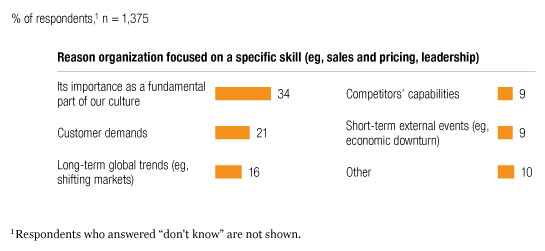
Lack of alignment
Despite the importance of capability building on the strategic agenda, executives’ responses indicate they’re not very good at executing: only about a quarter think their companies’ training programs are “extremely” or “very effective” in preparing various employee groups to drive business performance or improve the overall performance of their companies (Exhibit 2).
The survey results also indicate a potential explanation: training programs are misaligned with what is thought to be the capability most important to a company’s business performance. Only 33 percent of respondents say their training and skill-development programs focus on developing their companies’ most important capability.
Leadership skill, for example, is considered by the majority of respondents to be the capability that contributes most to performance. Yet only 35 percent of respondents say they focus on it. And only 36 percent of executives consider their companies better than competitors at leadership development.
Room for improvement
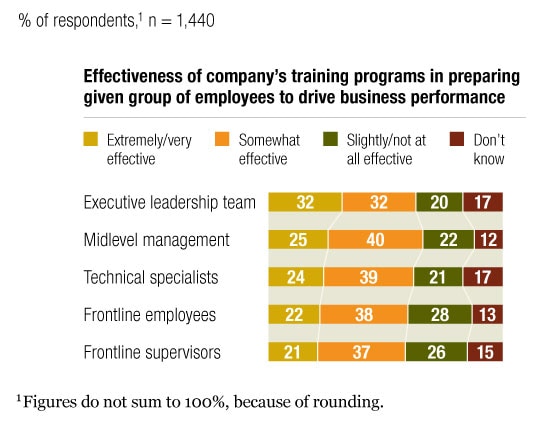
In addition, companies do not focus on day-to-day activities that could maintain or improve the capability that contributes the most to their business performance. For example, only 41 percent of respondents whose companies focus on supply chain management spend time defining roles, responsibilities, and decision rights for key positions, and just 39 percent set targets and track metrics.
Ineffective training methods
Companies tend to rely on on-the-job teaching (60 percent of respondents use this method “exclusively” or “extensively”), but no more than a third use any other method of training extensively (Exhibit 3). As companies try to replicate or scale up their training across more geographies, alternative ways of delivering it will become necessary. In addition, our experience shows that on-the-job training is most effective when it is reinforced through some sort of formal teaching and feedback loop.
Respondents at companies whose training programs are effective in maintaining or improving the drivers of business performance also say their companies pay more attention to tools that support or enable capability building, such as standard operating procedures, IT systems, and target setting and metric tracking.
Training methods
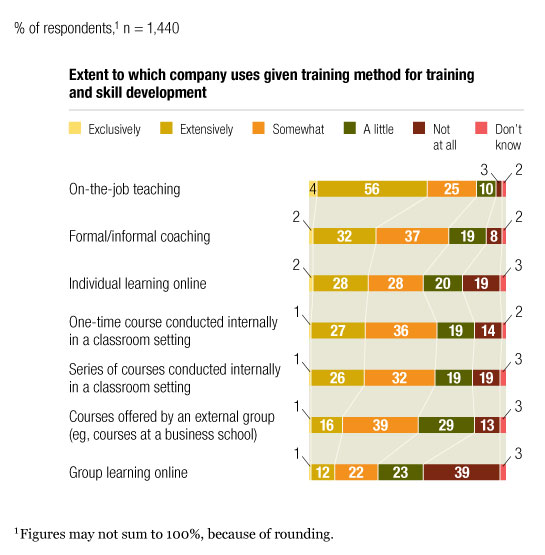
What else goes wrong
Companies also struggle to measure the impact of training on business performance: 50 percent of respondents say their companies keep track of direct feedback, and at best 30 percent use any other kind of metric. In addition, a third of respondents don’t know the return on their companies’ training investment. Because companies don’t know the impact of training, they appear to set their agendas using different measures, including prioritizing by employee role, which may not actually result in the most impact to the bottom line.
Executives at companies where training is reported to be least effective, for example, are more likely to invest in training for the leadership team and least likely to spend on the front line—despite this group’s more immediate impact on operations. In contrast, effective companies invest the most in training the front line (Exhibit 4).
In addition, although resistance to change is often viewed as a barrier to building new capabilities, almost as many respondents to this survey identified a lack of resources and an unclear vision as barriers (Exhibit 5).
Opportunity at the front line
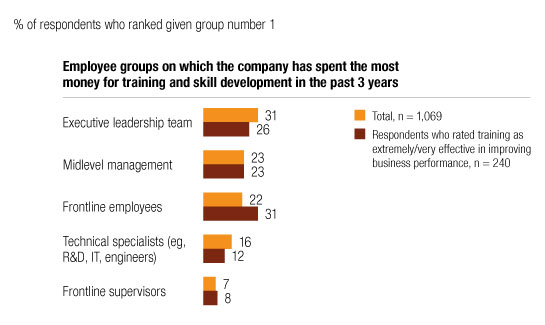
Top challenges
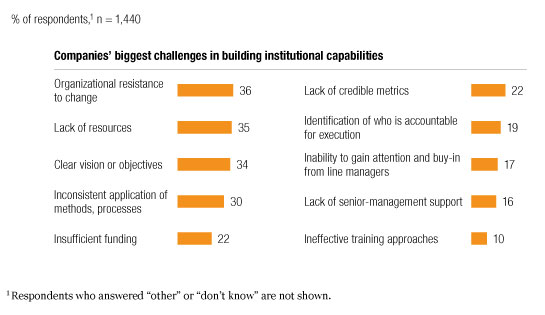
When senior leaders engage
Seventy percent of senior executives say capability building is among their companies’ top three priorities, compared with 58 percent of respondents overall and 48 percent of respondents in HR (Exhibit 6). Accordingly, when senior leaders set the training agenda, capability building is more often explicitly linked to immediate business goals than when other groups do so. For example, 38 percent of respondents at companies where senior leaders are involved in setting the training agenda say their companies’ key training and skill-development programs are focused on building or maintaining the companies’ number one skill priority, compared with 28 percent at companies where HR sets the agenda. Further, at companies where senior leaders set the agenda, 17 percent spend between 6 percent and 10 percent of their operating budget on training and skill development, compared with the much lower 6 percent and 8 percent, respectively, who spend the same at companies where HR or business unit leaders set the agenda.
Perhaps not surprisingly, at companies where senior executives set the training agenda, the training and skill-development programs are seen as more effective in driving business performance, though there is still much room for improvement. When senior leaders set the agenda, a quarter of the respondents view the program as effective, compared with 20 percent overall.
A strategic priority
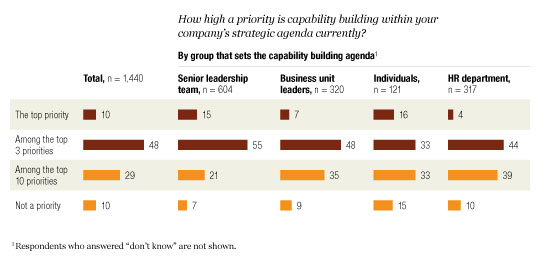
Looking ahead
-
Companies need to be more deliberate in understanding which capabilities truly impact business performance and align their training programs accordingly. Those that focus on leadership skill development are likelier to consider their training programs effective in improving business performance.
-
When senior leaders set the agenda for building capabilities, those agendas are more often aligned with the capability most important to performance.
-
Most companies focus on the capability executives say is most important to business performance because it’s a part of the companies’ culture, not for any competitive reason. While culture is a strong driver of effective capability building, companies that focus on certain capabilities for competitive reasons rather than cultural ones gain a stronger competitive advantage.

